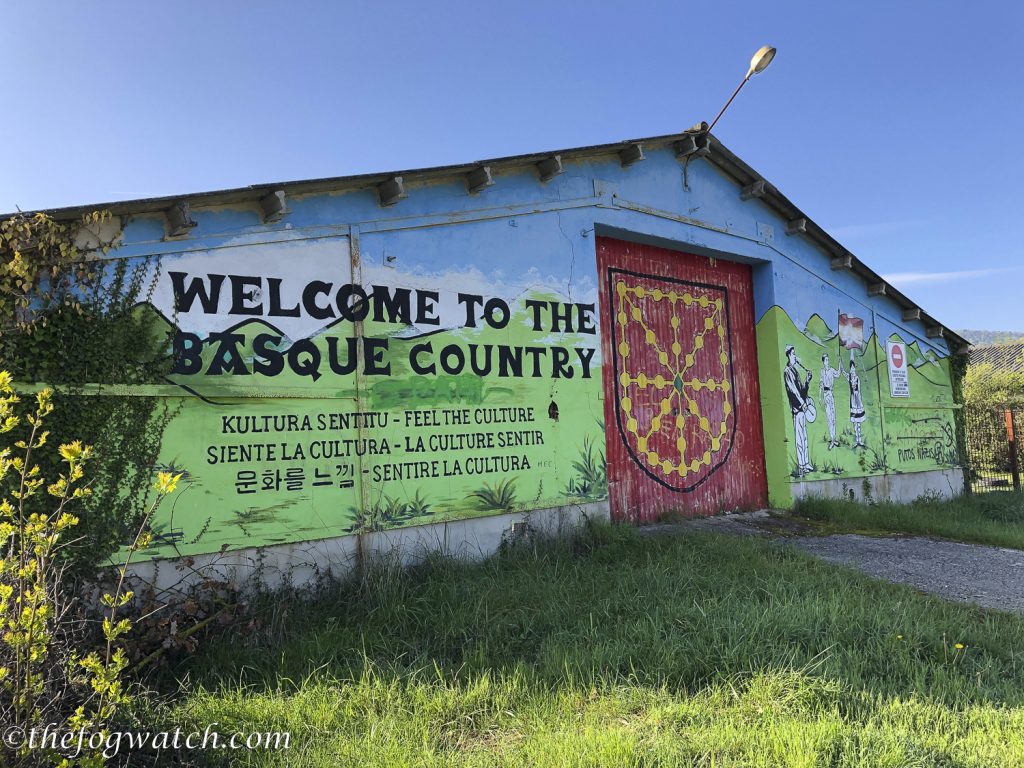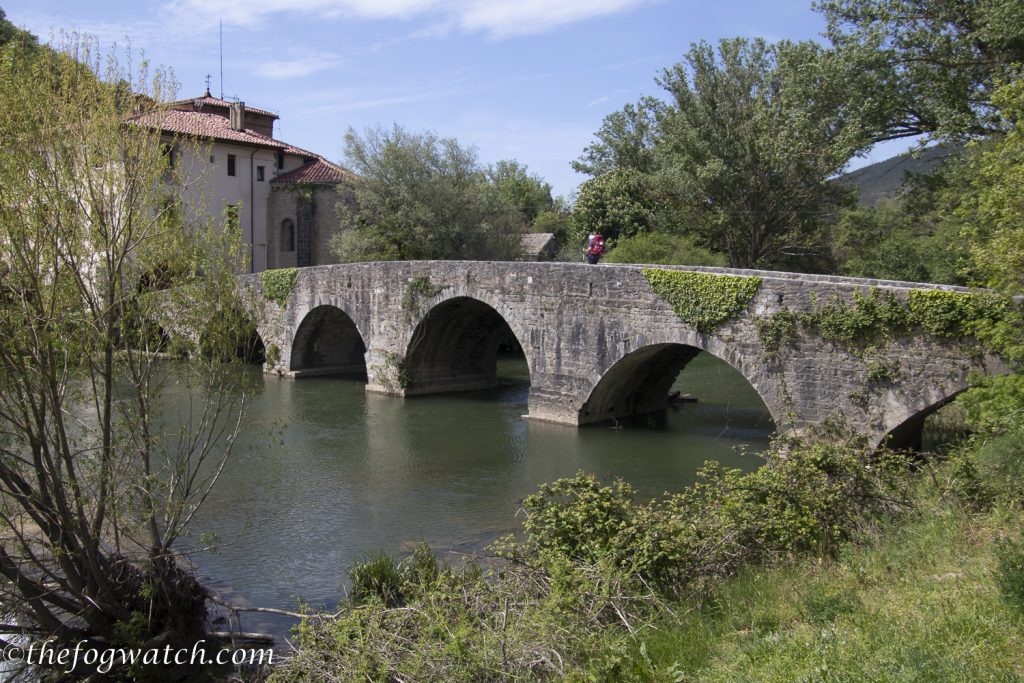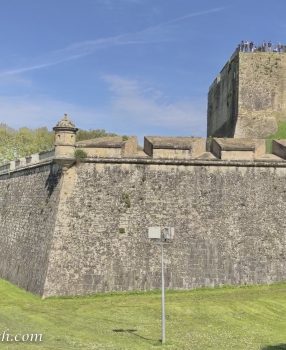Pamplona is the goal today. The morning dawned clear and cool as we headed back over the medieval bridge and left Zubiri behind us. It wasn’t long before the path began to climb. I looked back to see the town receding beneath us before we wound our way through leafy tunnels.

As we passed the Magnesite production plant on the right we could hear the muffled sounds of ore crushers. Some pilgrims find the proximity of industry distasteful. But it was always thus. Where there is industry there are towns with services for pilgrims. In medieval times there would have been the sounds of iron workers and stone breakers to make the very roads we walk on.

Without industry there would be no albergues or tiendas for the pilgrims. The Romans built a road through this area, making it a trade route that survived into medieval times and onward to today. The magnesite from this plant is used in the form of magnesium oxide as an oxidiser in the steel industry. So, if you drink from a steel cup or rest against steel railings on the bridge, then thank the workers at the magnesite plant as you pass. I felt grateful that I had the luxury of resources and time to be able to take the time to walk this road.

The hill was crested by the twin hamlets of Illaratz and Eskirotz where it started to rain and we were greeted with a large covered area and a water fountain established in 1917. We replenished our water bottles and rested for a few minutes before taking the road to the right.

About 400 metres down on the right is an ancient fort-like building known as La Abadia de Ilarratz (The Abbey). It is said to be a small Templar fort from the C13th which fits with the architecture and the pressed stone floor of the entrance. For the past few years, it has been under restoration by a South African pilgrim, Neill, who had walked the Camino and decided to buy the building from the church. He has done some impressive archeological research into the building, uncovering the site of the original altar and finding decorated plaster that includes pagan symbols — an early Christian practice to help set potential converts at ease. The bell has a wonderfully pure sound. The Abbey is well worth a visit (Neill speaks English).

Continuing on towards Pamplona, we pass a barn with a colourful reminder that we are still in the Basque country. The wall murals throughout Spain are quite remarkable.

We cross the bridge into Larrasoana in search of lunch. All is quiet, but after crossing the River Arga, we turn right as there is a bar at the end of the street and there we meet Olivier. Olivier runs the bar and he is in an expansive mood and ready to discuss philosophy— he sits with us while we enjoy a tortilla bocadillo (omelette in french bread), fresh squeezed orange juice, and tea.
Refreshed, we head out, back over the bridge and we decided to follow the river route into Pamplona. This meant bypassing the convent at Zabaldika run by the wonderful nuns of the Sacred Heart — Zabaldika is where pilgrims are allowed to climb the bell tower and ring the bell out over the valley. As we walked we heard the bell toll — such a pure sound! But for us, we were in the cool shade beside the river and we could see the convent/Albergue at the top of the hill.

Storks flew majestically overhead and songbirds sang in the bushes. It was a warm Spring day — a foretaste of the heat to come later in the month.

We emerged by a C12th medieval romanesque bridge — It replaced a Roman bridge that formed a vital crossing for the Roman road between Pamplona and Bordeaux. In the river (Rio Ultzama) you can see large-scale medieval works for controlling the flow of water through an ancient fulling mill used for pounding wool into felt — a source of income for the monastery that lies at the end of the bridge. It was tempting to stay at the Albergue there, but we had accommodation booked in Pamplona. The C12th monastery (Ermita de la Trinidad de Arre) once belonged to the monastery at Roncesvalles and is the most complete medieval monastery in Navarre. Trinidad’s local laws still apply dating from 1507. According to Gitliz and Davidson, “Villagers were to provide the hospice with bread for the entire year, half a pound per person, for all the pilgrims who arrive at the hospice at night, above and beyond the usual tax of 12 bushels of wheat.”

The C13th fulling mill produced felt, and the monastery maintained a church, a pilgrim rest house, and a granary provisioned by the local villagers. The monastery was also a claveria — a toll-house (literally, keeper of the keys) that controlled the bridge. It was certainly a strategic location.
Today you can see the remains of the water-powered paper mill and behind rises the hill of Monte Ezkaba, which we skirt as we enter Pamplona itself
Today Trinidad de Arre is effectively a suburb of Pamplona. And we passed beneath the arches of the monastery before making a long walk through the industrial and poorer suburbs to reach the town centre.

Entering Pamplona itself, we passed the fortifications of the town wall and entered over the drawbridge — which still is in operating condition!
Time for a rest day 🙂




I enjoyed your well-written Camino experience and excellent photos of a segment I so well remember walking. I hope to read my way through the rest of your pilgrimage and relive my own journey through your words and images.
Thanks Carmen — The pilgrimage is certainly memorable! I’ll be writing it up over the next several weeks 🙂 Cheers- Jerry
Beautifully recounted Jerry. We woke up this morning in midwinter Western France and you transported us to our October ’22 meanderings on and off the Camino. We must have been a week or two behind you. We ended up exploring the Sorogaín valley from the Camino stepping stones up to the French border. Stayed in Espinal for a few days, watching peregrinos passing through, chatting to several of them…and discovering a mystery at the stepping stones that no pilgrim seemed to notice: there was a stencilled letter on each block. Only legible if you paused for a cuppa next to the river. The letters spell D-E-B-O-R-D-E-R. “Overflow” in French, but not in Spanish or Basque so far as we can figure.
We think that you capture the essence of the Camino in your writings. Many thanks for posting. Alan and Shirley.
Thanks for your lovely comment, Alan and Shirley — The Camino is quite an experience isn’t it! And thank you for the mystery — it may of course simply be that they ordered the blocks from a French company just over the border, but interesting that it’s not in Spanish or Basque. I’ll have to look more closely next time! – Cheers – Jerry
This is absolutely lovely and thank you so much for this, for publishing this. It’s calming and almost another world for some of us. Love, Alan
Thanks Alan – It is indeed another world! And a great reminder for us to be our best selves 🙂